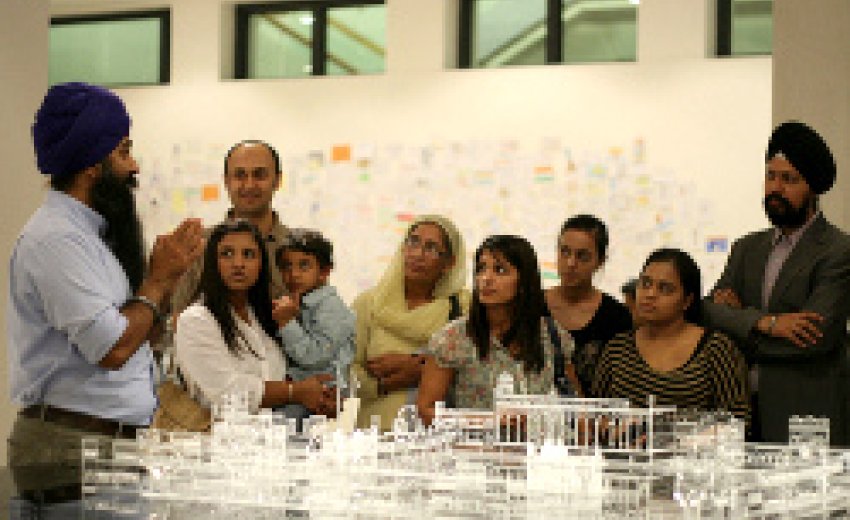|
An extraordinary image of the Golden Temple of Amritsar from a century ago sheds much needed light on the virtually hidden history of Sikh women, says author and historian Parmjit Singh
I fell in love with this exquisitely composed photograph during the course of our recent Golden Temple exhibition. What I like best about it is the way it connects me, both emotionally and intellectually, with the past.
I was not its only admirer; every time I delivered a gallery talk to eager visitors from around the world, this photographic study, taken in 1906 and showing the ebb and flow of pilgrims to this most famous of Sikh shrines, consistently mesmerised the crowds.
In an attempt to help these visitors connect to their own pasts, I would suggest that their great-grandmothers could well be one of the ladies in the picture. Although unlikely, statistically-speaking, not to mention completely unverifiable, they could at the very least see how their great-grandmothers might have dressed and conducted themselves on a visit to their holy of holies.
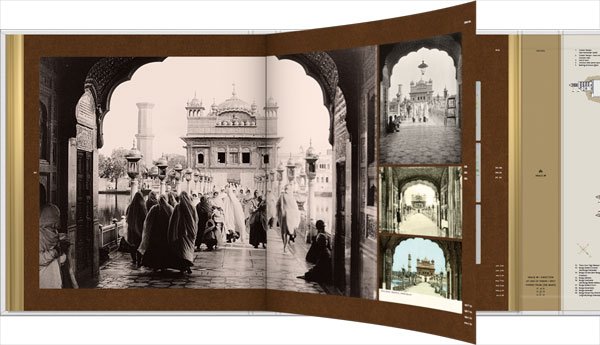 | | Pilgrims at the Golden Temple. Photograph by Herbert G. Ponting, January 1906. Toor Collection. |
Taking Inspiration From The Past
I would have loved to have met my own great-grandmother, Harnam Kaur, who would have been a young mother back then. As a child, my father remembers her as being fearless, frank and feisty because she had the blood of two daring brothers, Ali Singh and Mali Singh, flowing through her veins.
Sikhs kill Nawab Wazir Khan in the Battle of Sirhind in 1710
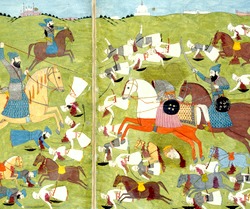 | | Sikhs kill Nawab Wazir Khan in the Battle of Sirhind in 1710. Detail from an illustrated folio from ‘Twarikh-i Jahandar Shah’, Avadh School, c. 1770. Image courtesy of the British Library. |
The exploits of these brother-warriors are recorded in the annals of history. When they challenged their employer, Wazir Khan of Sirhind, the Mughal overlord guilty of ordering the execution of the youngest sons of Guru Gobind Singh in 1705, the brothers were imprisoned.
They managed to escape to join Banda Bahadur’s peasant army, and played leading roles in the subsequent revolution and the very first Sikh government in Punjab. But the nascent kingdom was quickly quashed, and the brothers taken captive alongside Banda after the fall of Gurdas Nangal in 1715. They were tortured and executed the following year in Delhi, in front of baying crowds hungry for infidel blood.
Apparently, my great-grandmother drew her inspiration from the two brothers. In troubled times she would remind herself that she was ‘descended from Ali Singh and Mali Singh!’ before metaphorically dispatching anyone who had the bad fortune to cross swords with her.
She is one woman from the past I would love to have met. In the absence of a time-machine, however, I’m reliant upon captivating images such as this one to help me heave the past into the present.
In The Gorgeous East
Our photograph was one of several taken at the turn of the 20th century by British photographer, Herbert G. Ponting (1870-1935). Not long afterwards, this self-taught professional gained fame in very different climes, having been recruited as ‘camera-artist’ on Captain Scott’s Antarctic Expedition of 1910-13.
Herbert Ponting, photographer of the Golden Temple of the Sikhs
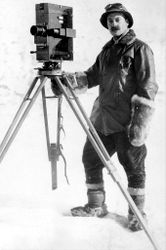 | | Camerawallah: Herbert Ponting with a cinematograph in Antarctica, January 1912. Private collection of Bruce Parker London, Ontario. |
Although the viewpoint chosen by Ponting was a familiar one to photographers who came to the Golden Temple before him, no one in my opinion came as close as he did in capturing the mood that permeates that sacred space or the zestful energy of its devotees. The manner in which he captures the quiet rhythm of life at the Golden Temple a century ago is quite remarkable.
Yet Ponting was no pioneer in the field of Sikh or Punjabi photography. In fact, his work comes exactly fifty years after the earliest known photograph of the Golden Temple was taken in 1856 (and is featured in The Golden Temple of Amritsar: Reflections of the Past (1808-1959)).
Photography first arrived in the subcontinent in the 1840s, a time when the British were preoccupied with the changing political situation in Punjab. It was not until after the annexation of the region in 1849 that photographic interest in its peoples and places was suitably stimulated.
Bedees, Sodhees and Ukalees
One of the most ambitious photographic initiatives in British India was an attempt to compile photographic records of the country’s tribes, races and castes. The project was the brainchild of India’s first viceroy and his wife, both keen patrons of photography.
In 1861, Lord and Lady Canning directed the Punjab government to submit photographs of ‘Sikhs in ordinary costume. Under this head should be given specimens of the priestly sects of Bedee (descendants of Gooroo Nanuk), and Sodhee (descendants of Guru Govind), also of Ukalees, and one or two of the Grunthees at Umritsar, also Muzbee Sikhs.’
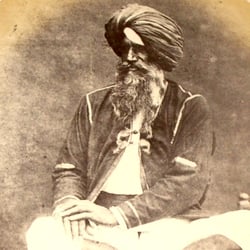 | | Smile: A Sikh of the Sindhu clan from Lahore poses for the most ambitious anthropological projects ever conceived. Photograph by anon., c. 1865. Toor Collection. |
The result was the multi-volume photographic work ‘The People of India’ (1868-1875), one of the most elaborate anthropological projects ever conceived. The project has been viewed both as an inevitable consequence of the expansion of imperial power in India and as evidence of a desire to scientifically demonstrate the superiority of the European races.
Ethnographers, anthropologists, criminologists and phrenologists held theories about facial and other physical features that supported the notion of a superior white race; these photographs bolstered such ideas and were sometimes taken to gather evidence to support them.
Regardless of the motives behind that project, the final work neglected to include any images of Sikh women. This pattern of omission, whether wilful or not, stretches from the earliest days of Sikhdom well into the 20th century.
Not So Close Encounters
Unlike men, who dominated both written and visual records, the contribution of Sikh women has largely been hidden from view. This is either because they’ve been neglected from the record books due to the prevailing attitudes of the patriarchal societies they lived in, or the rare historic records that do exist are just difficult to access, hidden deep within public and private archives.
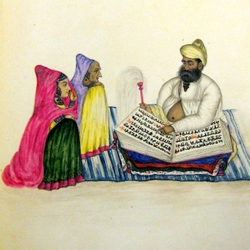 | | ‘Jut women & Sikh priest of Jalundhur reading Grunth’. Watercolour heightened with gold by Lanu ‘Draftman’, 1860. Toor Collection |
Another explanatory factor was simply one of female modesty; according to a British official who often toured the villages of Punjab, the ladies were ‘difficult to get a good look at, as at the approach of a stranger they disappear or hastily cover their faces. They are often handsome enough, but heavily decorated with silver bangles of all sizes and shapes. The nose is always pierced and contains some ornament. The ears and neck are covered with heavy silver bangles and chains.’
Just about the only place where Sikh women were visible to European eyes was the metropolitan city of Amritsar. The following wonderfully evocative description by Alfred Hugh Fisher, a travelling artist who painted his way through India and Burma with ‘pen and brush’ in 1911, serves as the perfect complement to Ponting’s lush visuals:
 Most of the women are dressed in long trousers, close fitting from the ankles to the knees and then bagging out loosely. They all have long veils which they wear like a hood; some are white but others scarlet, crimson, or orange, and some of green silk tissue strewn with silver stars and bordered with a ribbon of bright gold. It is the hour when even humble cloths take on luxurious tints, and richer stuff show all their utmost beauty in enhanced perfection. One passes near wearing trousers of pale blue with silver pattern, a silk coat of deep rose-pink, and over all a veil of pale canary-coloured tissue painted with roses and bordered deeply with gold. I thought “Was Soloman in all this glory…” but just then some children playing with a ball butted against me in sudden collision, and at the same time I encountered a Sikh gentleman who claimed direct descent from the second Guru, spoke English softly, and in leisured talk deplored to me the vanity of women. Most of the women are dressed in long trousers, close fitting from the ankles to the knees and then bagging out loosely. They all have long veils which they wear like a hood; some are white but others scarlet, crimson, or orange, and some of green silk tissue strewn with silver stars and bordered with a ribbon of bright gold. It is the hour when even humble cloths take on luxurious tints, and richer stuff show all their utmost beauty in enhanced perfection. One passes near wearing trousers of pale blue with silver pattern, a silk coat of deep rose-pink, and over all a veil of pale canary-coloured tissue painted with roses and bordered deeply with gold. I thought “Was Soloman in all this glory…” but just then some children playing with a ball butted against me in sudden collision, and at the same time I encountered a Sikh gentleman who claimed direct descent from the second Guru, spoke English softly, and in leisured talk deplored to me the vanity of women.
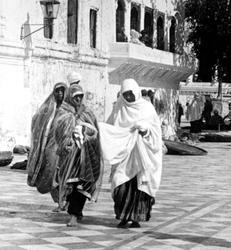 | | Sikh women in the Golden Temple precincts. Detail of a photograph by Herbert G. Ponting, January 1906. Courtesy of the New York State Archives. |
While posterity has not been overly kind to the memory of Sikh women, the GT1588 team’s research conducted over the past two decades categorically testifies to the often incredible sacrifices made by them at every juncture in our history.
To make up for the dearth of books on the subject, we have begun work on a major new work on the life and times of historic Sikh women, including queens, warriors, artists and activists. In the meantime, suitably reminded that ‘one picture is worth ten thousand words,’ we offer up this iconic image as a tribute to Sikh women of the past.
Learn More
Own your very own art print of Ponting’s fabulous photograph by ordering a copy here.
This article has been inspired by ‘The Golden Temple of Amritsar: Reflections of the Past (1808-1959)’ and ‘In The Master’s Presence: The Sikhs of Hazoor Sahib’.
Curator
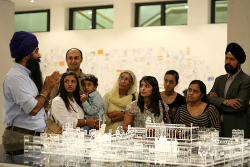 | | Curator Parmjit Singh delivering a gallery talk during the Golden Temple exhibition in London, 2011. Photo: Verinder Singh. |
About the Author
Parmjit Singh is the co-editor of ‘The Golden Temple of Amritsar: Reflections of the Past (1808-1959)’.
He is also the author of several other books on Sikh history including ‘Warrior Saints: Three Centuries of the Sikh Military Tradition’, ‘“Sicques, Tigers, or Thieves”: Eyewitness Accounts of the Sikhs (1606-1809)’ and ‘In The Master’s Presence: The Sikhs of Hazoor Sahib’.
He is currently working on a special edition of ‘Warrior Saints’, due to be published in 2012.
He is also a founding director of Kashi House, a not-for-profit social enterprise that produces illuminating resources on the culture and heritage of Punjab and the Sikhs. |
